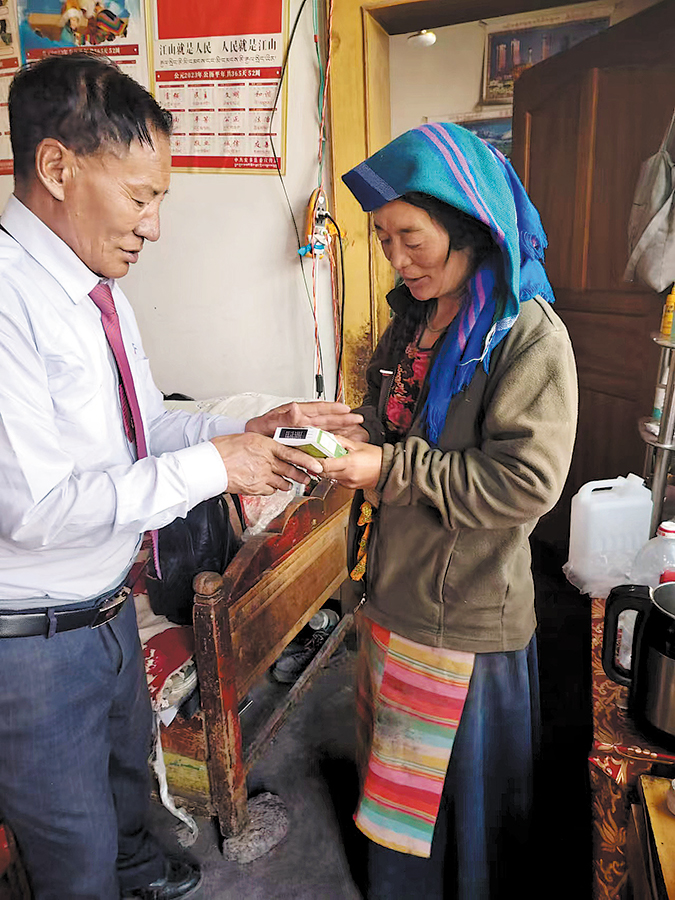Doctor dedicated to treating patients in remote county
Updated: 2024-09-09 (chinadaily.com.cn)  Print
Print 


Unique healthcare system established in vast, sparsely populated area

Tsega (left) gives medicine to a Tibetan woman after treating her at her home in Amdo county, Xizang autonomous region. [Photo provided to CHINA DAILY]
When it takes days to get to a city, seeking medical help can be a challenge.
This is the reality in many villages in Amdo county, Nagchu city of the Xizang autonomous region. The county spans approximately 100,000 square kilometers, an area as vast as Jiangsu province.
Tsega has served as a village doctor in Amdo for over 40 years, shuttling between grasslands and pastoral areas. "In the past, without vehicles, upon receiving messages about someone falling ill, sometimes I had to ride a horse, sometimes walk. It would take a four to five-day round trip to some villages," Tsega said.
There are 142 village doctors like Tsega in Amdo. Due to the vastness and sparse population, a unique healthcare system has been established here. Each township has a health center, with village doctors stationed in various villages. The health centers in towns and county hospitals provide regular training for village doctors.
Amdo is home to 45,000 people, mostly Tibetan herders who move with the seasons, setting up tents for grazing in the wilderness.
When villagers or nomadic herders fall ill, nearby village doctors travel to provide treatment and medication. For cases requiring better medical facilities, patients are transferred to township or city hospitals.
With an average elevation exceeding 5,000 meters, conditions in Amdo make high-altitude cardiovascular diseases, gout and high blood pressure relatively common.
In December 2022, while conducting medical outreach in the village of Zana, Tsega's vehicle veered into the Quma River.
"When the car was pulled out, my clothes were completely soaked. With the low winter temperatures on the plateau, they froze quickly," Tsega said. Without spare clothes, he continued his seven-day medical rounds.
Discovering his passion for healing and helping others in his early 20s, Tsega embarked on self-study of Tibetan and traditional Chinese medicines, and later pursued over a year of professional training at the People's Hospital in Nagchu, becoming proficient in Western medicine as well.
Drawing from his years of medical experience, he tailors treatment methods — be it Tibetan, Chinese, Western or a combination — based on each patient's needs. During his visits, he carries a variety of medications provided by the township hospital and purchases some himself.
Tsega believes that soaking in hot springs can help alleviate or prevent illnesses related to high altitude. Over the past decade, he has personally funded annual hot spring activities for the elderly, weak and disabled across the area.
Later, he applied for government funding of 200,000 yuan ($2,800) and helped build a hot spring pool in the village.
In 1974, Tsega collaborated with personnel from the Lanzhou military and geological teams for a 40-day filming project, capturing the beauty and fragility of the Yangtze River's source. Since then, he has dedicated his spare time to cleaning up the surrounding area, contributing to environmental protection efforts.
"The Yangtze River originates in Amdo, and is a precious natural asset for us. We hope more people will understand this and raise awareness for environmental conservation," he said.
Tsega, a Tibetan, joined the Communist Party of China in 1992 and recently became the deputy head of a volunteer team dedicated to safeguarding the water resources and environment at the Yangtze River's source in Amdo.
In July last year, a film crew arrived at the source of the river to shoot a documentary, with Tsega and other volunteers leading the way. Due to high water levels, the vehicle Tsega was in was swept over 200 meters downstream.
Despite being in his 70s, Tsega prioritized the rescue of others by staying on the vehicle's roof for 24 hours before being rescued. Inspired by his leadership, over 300 party members have joined the team. They patrol, clean up litter, protect wildlife and contribute to the preservation of the environment at the source of the Yangtze River.
Guan Wencheng contributed to this story.
yangdongjie@chinadaily.com.cn








